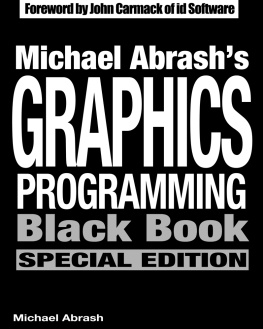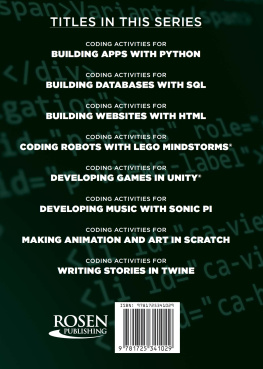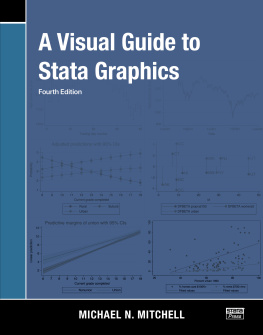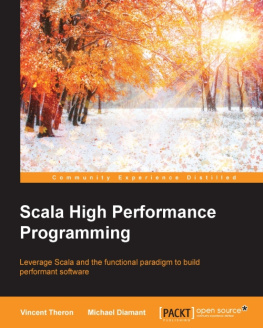Michael Abrashs Graphics Programming Black Book, Special Edition
Michael Abrashs Graphics Programming Black Book, Special Edition
Michael Abrash
Introduction
What was it like working with John Carmack on Quake? Like being strapped onto a rocket during takeoffin the middle of a hurricane. It seemed like the whole world was watching, waiting to see if id Software could top Doom; every casual e-mail tidbit or conversation with a visitor ended up posted on the Internet within hours. And meanwhile, we were pouring everything we had into Quakes technology; Id often come in in the morning to find John still there, working on a new idea so intriguing that he couldnt bear to sleep until he had tried it out. Toward the end, when I spent most of my time speeding things up, I would spend the day in a trance writing optimized assembly code, stagger out of the Town East Tower into the blazing Texas heat, and somehow drive home on LBJ Freeway without smacking into any of the speeding pickups whizzing past me on both sides. At home, Id fall into a fitful sleep, then come back the next day in a daze and do it again. Everything happened so fast, and under so much pressure, that sometimes I wonder how any of us made it through that without completely burning out.
At the same time, of course, it was tremendously exciting. Johns ideas were endless and brilliant, and Quake ended up establishing a new standard for Internet and first-person 3-D game technology. Happily, id has an enlightened attitude about sharing information, and was willing to let me write about the Quake technologyboth how it worked and how it evolved. Over the two years I worked at id, I wrote a number of columns about Quake in Dr. Dobbs Sourcebook, as well as a detailed overview for the 1997 Computer Game Developers Conference. You can find these in the latter part of this book; they represent a rare look into the development and inner workings of leading-edge software development, and I hope you enjoy reading them as much as I enjoyed developing the technology and writing about it.
The rest of this book is pretty much everything Ive written over the past decade about graphics and performance programming thats still relevant to programming today, and that covers a lot of ground. Most of Zen of Graphics Programming, 2nd Edition is in there (and the rest is on the CD); all of Zen of Code Optimization is there too, and even my 1989 book Zen of Assembly Language, with its long-dated 8088 cycle counts but a lot of useful perspectives, is on the CD. Add to that the most recent 20,000 words of Quake material, and you have most of what Ive learned over the past decade in one neat package.
Im delighted to have all this material in print in a single place, because over the past ten years Ive run into a lot of people who have found my writings usefuland a lot more who would like to read them, but couldnt find them. Its hard to keep programming material (especially stuff that started out as columns) in print for very long, and I would like to thank The Coriolis Group, and particularly my good friend Jeff Duntemann (without whom not only this volume but pretty much my entire writing career wouldnt exist), for helping me keep this material available.
Id also like to thank Jon Erickson, editor of Dr. Dobbs, both for encouragement and general good cheer and for giving me a place to write whatever I wanted about realtime 3-D. It still amazes me that I was able to find time to write a column every two months during Quakes development, and if Jon hadnt made it so easy and enjoyable, it could never have happened.
Id also like to thank Chris Hecker and Jennifer Pahlka of the Computer Game Developers Conference, without whose encouragement, nudging, and occasional well-deserved nagging there is no chance I would ever have written a paper for the CGDCa paper that ended up being the most comprehensive overview of the Quake technology thats ever likely to be written, and which appears in these pages.
I dont have much else to say that hasnt already been said elsewhere in this book, in one of the introductions to the previous volumes or in one of the astonishingly large number of chapters. As youll see as you read, its been quite a decade for microcomputer programmers, and I have been extremely fortunate to not only be a part of it, but to be able to chronicle part of it as well.
And the next decade is shaping up to be just as exciting!
Michael Abrash
Bellevue, Washington
May 1997
Foreword
I got my start programming on Apple II computers at school, and almost all of my early work was on the Apple platform. After graduating, it quickly became obvious that I was going to have trouble paying my rent working in the Apple II market in the late eighties, so I was forced to make a very rapid move into the Intel PC environment.
What I was able to pick up over several years on the Apple, I needed to learn in the space of a few months on the PC.
The biggest benefit to me of actually making money as a programmer was the ability to buy all the books and magazines I wanted. I bought a lot. I was in territory that I new almost nothing about, so I read everything that I could get my hands on. Feature articles, editorials, even advertisements held information for me to assimilate.
John Romero clued me in early to the articles by Michael Abrash. The good stuff. Graphics hardware. Code optimization. Knowledge and wisdom for the aspiring developer. They were even fun to read. For a long time, my personal quest was to find a copy of Michaels first book, Zen of Assembly Language. I looked in every bookstore I visited, but I never did find it. I made do with the articles I could dig up.
I learned the dark secrets of the EGA video controller there, and developed a few neat tricks of my own. Some of those tricks became the basis for the Commander Keen series of games, which launched id Software.
A year or two later, after Wolfenstein-3D, I bumped into Michael (in a virtual sense) for the first time. I was looking around on M&T Online, a BBS run by the Dr. Dobbs publishers before the Internet explosion, when I saw some posts from the man himself. We traded email, and for a couple months we played tag-team gurus on the graphics forum before Dooms development took over my life.
A friend of Michaels at his new job put us back in touch with each other after Doom began to make its impact, and I finally got a chance to meet up with him in person.
I talked myself hoarse that day, explaining all the ins and outs of Doom to Michael and an interested group of his coworkers. Every few days afterwards, I would get an email from Michael asking for an elaboration on one of my points, or discussing an aspect of the future of graphics.
Eventually, I popped the questionI offered him a job at id. Just think: no reporting to anyone, an opportunity to code all day, starting with a clean sheet of paper. A chance to do the right thing as a programmer. It didnt work. I kept at it though, and about a year later I finally convinced him to come down and take a look at id. I was working on Quake.
Going from Doom to Quake was a tremendous step. I knew where I wanted to end up, but I wasnt at all clear what the steps were to get there. I was trying a huge number of approaches, and even the failures were teaching me a lot. My enthusiasm must have been contagious, because he took the job.
Much heroic programming ensued. Several hundred thousand lines of code were written. And rewritten. And rewritten. And rewritten.













